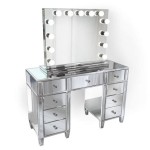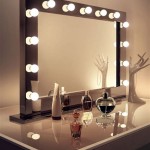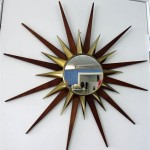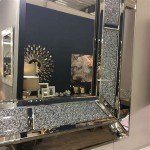Vintage Victorian Hand Mirrors: A Reflection of Elegance and Craftsmanship
Vintage Victorian hand mirrors represent more than just a means of self-reflection; they are tangible pieces of history, reflecting the aesthetic sensibilities and craftsmanship of the Victorian era (roughly 1837 to 1901). These mirrors, often adorned with intricate details and crafted from a variety of materials, offer a glimpse into the lives of the people who used them and the society they inhabited. Understanding the design elements, materials, and historical context of these mirrors provides valuable insights into the Victorian era and the enduring allure of antique objects.
The Victorian era was characterized by significant social, economic, and technological changes. This period witnessed the rise of industrialization, the expansion of the British Empire, and a burgeoning middle class. These factors influenced various aspects of life, including fashion, home décor, and personal grooming. Victorian society placed a strong emphasis on appearances and etiquette, contributing to the popularity and prevalence of hand mirrors. These mirrors served not only a practical purpose but also as status symbols, reflecting the owner's wealth and taste.
The availability of mass-produced goods, coupled with advancements in glassmaking technology, made mirrors more accessible to a wider segment of the population. However, the high-end vintage Victorian hand mirrors were often meticulously crafted by skilled artisans, using precious materials and intricate designs, differentiating them from simpler, mass-produced versions.
Key Design Elements of Victorian Hand Mirrors
Victorian hand mirrors are distinguished by their elaborate designs, often incorporating a blend of stylistic influences. One prominent characteristic is the use of ornate frames. These frames were frequently made of metals such as silver, brass, or gold-plated alloys, and adorned with intricate carvings, repoussé work (a metalworking technique where metal is hammered from the reverse side to create a raised design), and filigree detailing (delicate ornamental work made from fine wires). The designs often featured floral motifs, scrolls, and classical figures, reflecting the Victorian penchant for romanticism and historical revivalism.
Another significant design element is the handle. Victorian hand mirror handles were designed to be both functional and aesthetically pleasing. They were typically made of the same material as the frame and often incorporated similar decorative elements. Some handles were ergonomically shaped for a comfortable grip, while others were more ornate and decorative, emphasizing the mirror's status as a luxury item. Materials such as ivory, bone, and exotic woods were also used for handles, adding to the overall opulence of the piece.
The shape of the mirror itself also varied. While circular and oval mirrors were common, other shapes, such as rectangular and shield-shaped mirrors, were also produced. The edges of the mirrors were often beveled, adding a touch of elegance and sophistication. The mirror glass itself was typically of high quality, providing a clear and undistorted reflection.
Furthermore, embellishments such as gemstones, enamel work, and inlaid materials were frequently incorporated into the design of Victorian hand mirrors. These embellishments added color, texture, and visual interest, making each mirror a unique work of art. The choice of materials and embellishments often reflected the owner's personal taste and social standing.
Materials Used in Crafting Victorian Hand Mirrors
The materials used in the construction of vintage Victorian hand mirrors played a crucial role in their overall appearance, durability, and value. Metals were a primary component, with silver being a particularly popular choice for high-end mirrors. Sterling silver mirrors were often hallmarked, indicating the silver's purity and origin. These hallmarks provide valuable information for collectors and historians, helping to authenticate and date the pieces.
Brass was another commonly used metal, particularly for more affordable mirrors. Brass frames were often plated with gold or silver to enhance their appearance. The plating process involved applying a thin layer of precious metal to the brass base, creating a more luxurious look. Over time, the plating may wear away, revealing the brass underneath, which can be an indicator of the mirror's age and use.
Wood was also used for handles and frames, especially for mirrors intended for everyday use. Exotic woods such as mahogany, rosewood, and ebony were prized for their rich colors and intricate grain patterns. These woods were often polished to a high sheen, enhancing their natural beauty. In some cases, the wood was inlaid with other materials, such as mother-of-pearl or ivory, adding to the mirror's decorative appeal.
Other materials used in Victorian hand mirrors included celluloid, a type of early plastic that was used to simulate ivory or tortoiseshell; enamel, which was used to create colorful decorative designs; and gemstones, which were often set into the frame or handle to add sparkle and brilliance. The variety of materials used reflects the ingenuity and resourcefulness of Victorian artisans.
The glass used in Victorian hand mirrors was typically of high quality, often made using techniques that produced a clear and reflective surface. Silvering, the process of applying a thin layer of silver to the back of the glass, was used to create the reflective surface. The quality of the silvering can affect the mirror's clarity and longevity. Deterioration of the silvering is a common issue with antique mirrors, resulting in dark spots or a cloudy appearance.
The Historical and Social Significance of Victorian Hand Mirrors
Vintage Victorian hand mirrors provide valuable insights into the historical and social context of the Victorian era. They reflect the Victorian emphasis on appearance, etiquette, and social status. The act of using a hand mirror was often a carefully choreographed ritual, reflecting the importance placed on personal grooming and presentation.
The mirrors also served as a means of self-expression and personal identity. The choice of mirror design, materials, and embellishments reflected the owner's individual taste and social standing. Owning a finely crafted hand mirror was a symbol of affluence and refinement, allowing individuals to project a desired image to the world.
Furthermore, Victorian hand mirrors were often associated with femininity and domesticity. They were typically found in dressing tables, boudoirs, and other private spaces associated with women. The mirrors were used not only for grooming but also as decorative objects, adding to the overall ambiance of the room. They can be seen as artifacts central to the construction and performance of Victorian femininity.
The mirrors also played a role in the development of the beauty industry. The rise of mass-produced cosmetics and grooming products during the Victorian era led to an increased demand for mirrors. Hand mirrors became essential tools for applying makeup, styling hair, and maintaining a fashionable appearance. The mirrors, therefore, are inextricably linked to the commercialization of beauty standards during this period.
Moreover, Victorian hand mirrors often carry sentimental value, having been passed down through generations as family heirlooms. These mirrors represent a tangible connection to the past, preserving memories and stories of previous owners. They serve as reminders of the changing social norms and aesthetic preferences of different eras.
These mirrors also appear in literature and art of the period, reflecting their cultural prominence. They are often used as symbols of vanity, beauty, or self-awareness, contributing to the rich tapestry of Victorian culture. Examining these depictions provides a deeper understanding of the role hand mirrors played in the lives and imaginations of Victorians.
In conclusion, vintage Victorian hand mirrors are more than just reflective surfaces. They are artifacts that encapsulate the aesthetic sensibilities, social values, and technological advancements of the Victorian era. Their intricate designs, diverse materials, and historical significance make them highly sought-after collector's items and valuable resources for understanding the past.

Antique Victorian Brass Footed Cherub Hand Mirror

Antique Hand Mirror Cloisonne Enamel Victorian Vanity 19th Century Distressed Bevelled Wall 1800s

Vintage Art Nouveau Hand Mirror In Broe

Hand Held Mirror Antique Victorian Ornate Gold

Antique Victorian Blue Opaline Glass Vanity Hand Mirror 1800

Pin By ಌಌஜbebeஜ ಌ Conn On Mirror The Wall Whose Fairest Of Us All I Love Mirrors They Let One Pass Through Surface Things Vintage Hand

Silver Victorian Hand Mirror 10 H New Deluxe

Premium Photo Victorian Watercolor Vintage Green Hand Mirror Ilration Pink Clipart

Unicorn Studio Veronese Design Vintage Skull Brooch Victorian Hand Mirror Cold Cast Resin Broe Finish Statue Home Decor 10 Inch Wu77685a4 Com

Lovely Vintage Dresser Vanity Hand Mirror Petit Point Pink Roses Glass Ruby Lane








